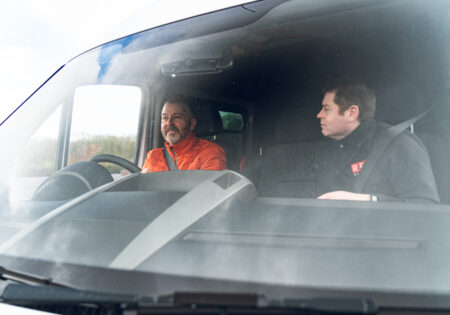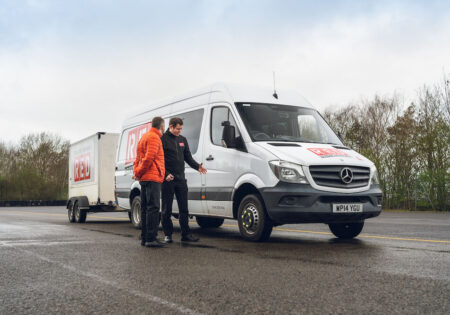How to extend the range of your EV
10 June, 2021
Range anxiety is a potential barrier to the widescale adoption of fleet electric cars and vans.
Battery technology and better infrastructure will improve rapidly to help overcome some of these worries but just as with petrol and diesel cars – only more so – more efficient driving means longer distances between stops and more effective, less costly, working.
Early adopters have benefited from RED’s specialist EV training courses, which helps EV drivers spend more time on the road and less time charging.
Getting the best possible range from electric vehicles will have a big impact on the operational capacity of your fleet, and that means ensuring employees are driving in the right way, and understand the nuances of driving their EVs too.
Here are six key areas for better EV driving from RED’s Commercial Director Andy Mitchell.
1. Taking the most direct, not the fastest, route
“Motorway speeds significantly deplete electric batteries, so try a more direct, but possibly slower average speed route,” says Andy.
It need not severely impact journey times: navigation is very accurate in terms of time taken and traffic conditions ahead – especially as it often now uses real time data from smartphones in vehicles – so there should be clear route options to choose from before setting off. By going direct, the time taken might not be as much as you think, and if you don’t have to charge on the journey as a result, that should be factored in too.
Some navigation systems in EVs also take into account the severity of hills and bends that could affect battery life. Work with these systems, rather than trying to find a way to beat them. Choosing the right route is half the battle and can make a huge difference to range.
2. Pre-condition while you are still plugged in
Air con, heating and climate control are range killers. Try and get as much of the work of getting the car or van’s cabin up (or down) to temperature while it is still plugged in and before you set off. Then, the batteries don’t have to shoulder the load of cooling or heating, which can seriously deplete them.
“If you just start an EV and drive off, the battery will have to do a lot of work getting heating or air-conditioning to your preferred level. So always pre-condition the vehicle before setting off, while on a charge, if it has that function,” Andy reckons.
Then, if it is hot, be old fashioned and open the windows. You will lose less range from the extra drag of open windows than blasting the air con, and if it’s cold, use heated seats and steering wheel, if you have them, rather than the heater.
3. Be as light as possible, and check tyre pressures
Batteries are heavy, making electric cars are considerably weightier than equivalent petrol or diesel cars. So try to minimise carrying any unnecessary extra weight.
“Don’t lug about unnecessary items in the cabin or boot,” says Andy “You’ll pay to move that extra weight around in reduced range.”
Ensure you are keeping all that mass moving as efficiently as possible and one way is to make certain tyres are at their correct pressures. Underinflated tyres mean more work for the motor, and that will impact heavily on range.
4. Use regenerative braking
“Learn how your regenerative braking works,” Andy reckons. “Each vehicle will have a re-generation mode, in which the electric motor acts as a generator to recharge the battery and also act as a brake.”
Usually, regenerative braking will kick in when you lift off the accelerator, meaning you won’t have to use the brake pedal as you might with petrol or diesel cars.
Understanding when to lift off can seem counterintuitive at first: in a traditionally powered car or van, lifting off and letting momentum carry you along is good. But in an EV, it can be better to keep your foot on the accelerator until you have to ‘brake’ – otherwise you might slow down too early and have to waste energy speeding up again.
5. Keep on moving
As long as it is safe to do so, try and avoid coming to a stop at roundabouts, junctions and lights by judging what’s going on ahead and moving into the flow of traffic.
“Even ending up at a crawl is better than a full stop as a significant amount of energy is expended in moving a vehicle from stationary. Watch how HGV drivers do this – they will always try to keep some forward movement, however little,” says Andy.
6. Find out about eco features
EVs and PHEV are packed with battery-saving features and it pays to learn about them.
Many EVs have modes for saving battery power, such as eco modes which limit performance and the top speed, increasing regenerative braking and reducing air con, while PHEVs can usually hold batteries usage until they are best deployed, such as in the city rather than on a motorway.
“It can take a spot of reading and some experimentation to determine what works best for your specific vehicle,” Andy reckons.
“But where once it was all about how quickly you could get from A to B, now there’s a quite lot of satisfaction to be gained when you get to your destination with more battery life left than you expected. And more time on the road and less time charging will help your business too.”
RED Driver Risk Management offers a variety of EV familiarisation and EV driver training courses. Sessions can be tailored to a client’s specific needs and are delivered by specialist ADI coaches who are trained by The Energy Saving Trust. Call 01332 810 007 to find out more.
This content was published in conjunction with our friends at Allstar.





